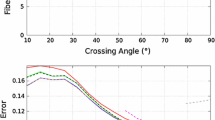Abstract
Existing clustering-based methods for segmentation and fiber tracking of diffusion tensor magnetic resonance images (DT-MRI) are based on a formulation of a similarity measure between diffusion tensors, or measures that combine translational and diffusion tensor distances in some ad hoc way. In this paper we propose to use the Fisher information-based geodesic distance on the space of multivariate normal distributions as an intrinsic distance metric. An efficient and numerically robust shooting method is developed for computing the minimum geodesic distance between two normal distributions, together with an efficient graph-clustering algorithm for segmentation. Extensive experimental results involving both synthetic data and real DT-MRI images demonstrate that in many cases our method leads to more accurate and intuitively plausible segmentation results vis-à-vis existing methods.




















Similar content being viewed by others
Notes
In our experiments, if \(\operatorname{dist}(B', C)\) is less than 0.05, log C (B′) is well approximated by B′−C. We use this constant value in Algorithm 1.
References
Abou-Moustafa, K.T., Ferrie, F.P.: A note on metric properties for some divergence measures: the Gaussian case. J. Mach. Learn. Res. 25, 1–15 (2012)
Alexander, D., Gee, J., Bajcsy, R.: Similarity measures for matching diffusion tensor images. In: British Machine Vision Conference, vol. 99, pp. 93–102 (1999)
Arsigny, V., et al.: Log-Euclidean metrics for fast and simple calculus on diffusion tensors. Magn. Reson. Med. 56, 411–421 (2006)
Basser, P.J., Mattiello, J., LeBihan, D.: MR diffusion tensor spectroscopy and imaging. J. Biophys. 66, 259–267 (1994)
Calvo, M., Oller, J.: A distance between multivariate normal distributions based in an embedding into a Siegel group. J. Multivar. Anal. 35, 223–242 (1990)
Coulon, O., Alexander, D.C., Arridge, S.: Diffusion tensor magnetic resonance image regularization. Med. Image Anal. 8(1), 47–68 (2004)
Descoteaux, M., Lenglet, C., Deriche, R.: Diffusion tensor sharpening improves white matter tractography. Proc. SPIE 6512, 65121J (2007)
Eriksen, P.S.: Geodesics connected with the Fisher metric on the multivariate normal manifold. In: Proc. GST Workshop, Lancaster, pp. 225–229 (1987)
Fletcher, P.T., et al.: Riemannian geometry for the statistical analysis of diffusion tensor data. Signal Process. 87(2), 250–262 (2007)
Imai, T., Takaesu, A., Wakayama, M.: Remarks on geodesics for multivariate normal models. Surv. Math. Ind. B(6), 125–130 (2011)
Jbabdi, S., Bellec, P., Toro, R., Daunizeau, J., Pélégrini-Issac, M., Benali, H.: Accurate anisotropic fast marching for diffusion-based geodesic tractography. Int. J. Biomed. Imaging 2008, 320195 (2008)
Kaufman, L., Rousseeuw, P.J.: Clustering by means of medoids. In: Dodge, Y. (ed.) Statistical Data Analysis Based on the L 1 Norm and Related Methods, pp. 405–416. North-Holland, Amsterdam (1987)
Lenglet, C., Rousson, M., Deriche, R., Faugeras, O.: Statistics on the manifold of multivariate normal distributions: theory and application to diffusion tensor MRI processing. J. Math. Imaging Vis. 25, 423–444 (2006)
Lovric, M., Min-Oo, M., Ruh, E.A.: Multivariate normal distributions parametrized as a Riemannian symmetric space. J. Multivar. Anal. 74(1), 36–48 (2000)
Maitra, R., Peterson, A.D., Ghosh, A.P.: A systematic evaluation of different methods for initializing the k-means clustering algorithm. In: IEEE Trans. Knowledge and Data Engineering (2010)
Moakher, M.: A differential geometric approach to the geometric mean of symmetric positive-definite matrices. SIAM J. Matrix Anal. Appl. 26, 735–747 (2005)
Moakher, M., Batchelor, P.G.: Symmetric positive-definite matrices: from geometry to applications and visualization. In: Visualization and Processing of Tensor Fields, pp. 285–298 (2006)
O’Donnell, L., Haker, S., Westin, C.-F.: New approaches to estimation of white matter connectivity in diffusion tensor MRI: elliptic PDEs and geodesics in a tensor-warped space. In: Proc. Med. Image Comput. Comp. Assisted Intervention, vol. 2488, pp. 459–466 (2002)
Otsu, N.: A threshold selection method from gray-level histogram. IEEE Trans. Syst. Man Cybern. SMC-9(1), 62–66 (1979)
Pennec, X., Fillard, P., Ayache, N.: A Riemannian framework for tensor computing. Int. J. Comput. Vis. 66(1), 41–46 (2006)
Sepasian, N., ten Thije Boonkkamp, J.H.M., Ter Haar Romeny, B.M., Vilanova, A.: Multivalued geodesic ray-tracing for computing brain connections using diffusion tensor imaging. SIAM J. Imaging Sci. 5, 483–504 (2012)
Skovgaard, L.T.: A Riemannian geometry of the multivariate normal model. Scand. J. Stat. 11, 211–233 (1984)
Smith, S.T.: Covariance, subspace, and intrinsic Cramér–Rao bounds. IEEE Trans. Signal Process. 53(5), 1610–1630 (2005)
Tsuda, K., Akaho, S., Asai, K.: The em algorithm for kernel matrix completion with auxiliary data. J. Mach. Learn. Res. 4, 67–81 (2003)
Wang, Z., Vemuri, B.: DTI segmentation using an information theoretic tensor dissimilarity measure. IEEE Trans. Med. Imaging 24(10), 1267–1277 (2005)
Wiegell, M., Tuch, D., Larson, H., Wedeen, V.: Automatic segmentation of thalamic nuclei from diffusion tensor magnetic resonance imaging. NeuroImage 19, 391–402 (2003)
Ziyan, U., Tuch, D., Westin, C.F.: Segmentation of thalamic nuclei from DTI using spectral clustering. In: Proc. Med. Image Comput. Comp. Assisted Intervention, pp. 807–814 (2006)
Acknowledgements
This research was supported in part by the Center for Advanced Intelligent Manipulation, the Biomimetic Robotics Research Center, the BK21+ program at SNU-MAE, and SNU-IAMD.
Author information
Authors and Affiliations
Corresponding author
Appendix: Triangle Inequality Counterexample
Appendix: Triangle Inequality Counterexample
In [1] it is claimed that the distance metrics (2) and (3) satisfy all the metric axioms including the triangle inequality. The following simple counterexample shows that this is not the case. Consider the following three normal distributions a, b and c on \(\mathcal{N}(1)\):
The distances calculated using the proposed metrics are given in Table 2.
Both metrics violate the triangle inequality, i.e., \(\operatorname{dist}(a,b) + \operatorname{dist}(b,c) \ngeq \operatorname{dist}(c,a)\).
Rights and permissions
About this article
Cite this article
Han, M., Park, F.C. DTI Segmentation and Fiber Tracking Using Metrics on Multivariate Normal Distributions. J Math Imaging Vis 49, 317–334 (2014). https://doi.org/10.1007/s10851-013-0466-z
Published:
Issue Date:
DOI: https://doi.org/10.1007/s10851-013-0466-z




